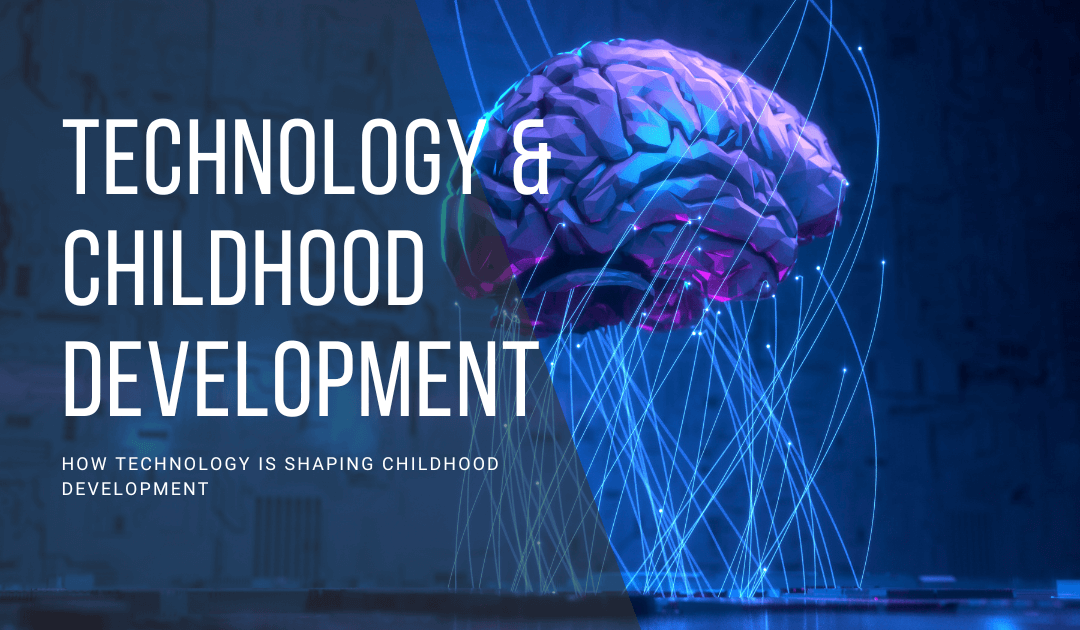Just as we marvel at the transformation of a caterpillar into a butterfly, we watch with the same amazement as our children are born into a world vastly different from the one we knew. The era of climbing trees and playing hide-and-seek until dusk has been replaced by a landscape awash with beeps, clicks, and swipes.
The playgrounds of old now fit right in their hands, as technology has become a part of their everyday lives.
We may wonder, even stress – how is this technology everywhere affecting our kids’ growth? Will it hold them back or help them thrive on their way to adulthood?
Let’s dive into the fascinating world where technology and childhood development meet. Join us as we explore this new territory together and uncover how technology is shaping our children’s growth.
What is Childhood Development?
Before we get into technology, let’s take a moment to understand what childhood development is all about.
It’s basically how kids grow and learn to become independent adults. It covers everything from physical and cognitive growth to social and emotional development, starting from infancy all the way through adolescence.
The early years, especially from birth to 8 years old, are super important for building the foundations of childhood development.
The Increasing Presence of Technology in Children’s Lives:
It’s undeniable that technology is becoming more deeply embedded in children’s lives with each passing day. With advances in digital media, children now have an unprecedented access to information and educational resources.
It’s not uncommon to see toddlers skillfully navigating touch screens or school-age children completing homework assignments online. Even the classroom experience has evolved with interactive white boards and online learning platforms becoming standard fixtures.
This presence of technology is creating digitally native generations, who are growing up with a vast virtual world at their fingertips. But is this new reality a cause for concern or comfort?
The answer lies in understanding the profound implications, both positive and negative, of technology on childhood development.
The Benefits of Technology in Childhood Development:
In the context of childhood development, technology can be an empowering tool that brings about numerous benefits.
One of the most significant advantages is the enhancement of cognitive skills. By engaging with interactive apps and games, children can develop problem-solving skills, improve their memory, and strengthen their decision-making abilities. For instance, educational video games can stimulate a child’s strategic thinking and planning skills.
Furthermore, the wealth of educational resources available online is virtually limitless. Children can access e-books, online tutorials, academic content, and interactive learning platforms that cater to different learning styles. This can supplement traditional classroom-based learning and even provide learning opportunities for those unable to attend school.
Interactive digital tools can also make learning more engaging and fun, fostering a love for education from a young age. Technology therefore serves as a potent aid in promoting cognitive development and widening access to educational resources.
Downsides of Technology in Childhood Development:
While it’s clear that technology has its place in childhood development, overuse or misuse can heighten some already existing problems or give rise to new ones. Here are some potential downsides to consider:
1. Decreased Creativity: Children may become overly dependent on pre-programmed applications and games, inhibiting their natural ability to think creatively and creatively problem-solve. This reliance on pre-determined solutions can limit their capacity to generate original ideas and find unique approaches to challenges, which are crucial skills for their overall cognitive development. By encouraging a balance between technology use and other activities that foster open-ended thinking, parents and educators can help nurture and cultivate children’s innate creativity and problem-solving abilities.
2. Developmental Delays: Excessive screen time can contribute to delays in the development of specific motor skills in young children, such as the crucial ability to hold a pencil and manipulate it with precision. These delays can hinder their overall fine motor development, affecting tasks like writing, drawing, and other activities that require hand-eye coordination and dexterity. It is important to limit screen time and encourage alternative activities that promote the healthy development of these essential skills.
3. Behavioral Issues: Overuse of technology may potentially contribute to various behavioral issues, including addiction, attention deficit disorders, and an increase in aggressive behavior. These issues can manifest in different ways and impact individuals of all ages, affecting their overall well-being and social interactions. It is important to be aware of the potential consequences and find a healthy balance in our use of technology to reduce these risks.
4. Fostering Passive Learning: In the world of technology, kids often end up passively receiving information instead of actively seeking and engaging with it. This passive approach can hinder the development of important skills like critical thinking, problem-solving, and knowledge acquisition. So, it’s crucial to recognize the downsides of passive learning and encourage children to actively participate and interact with educational content for a more effective learning experience.
5. Data Privacy Concerns: In today’s digital age, the issue of children’s data privacy has become a growing concern. With the widespread use of apps and online services, there is an increasing amount of personal information being collected about young users. This raises questions about how this data is being stored, used, and protected. Parents and guardians need to be vigilant in understanding the privacy policies and practices of these platforms to ensure the safety and security of their children’s sensitive information.
6. Reduced Family Time: Excessive device usage can lead to a decrease in the amount of quality time children spend with their family. This can have a detrimental impact on emotional bonding, as it limits opportunities for meaningful interactions, shared experiences, and fostering a sense of togetherness. It is important to strike a balance between screen time and engaging in activities that promote strong family connections and emotional well-being.
While these potential downsides don’t mean we should eliminate technology from children’s lives, they do emphasize the need for parents and educators to manage and monitor its use carefully, ensuring it aids rather than hinders their development.
Strategies for Effective and Safe Use of Technology in Childhood Development
Rather than resorting to a total ban on technology, which could possibly disadvantage children in a world where digital skills are increasingly important, a strategic approach focusing on guided and purposeful use of technology can be more beneficial.
Here are a few strategies:
1. Set Reasonable Time Limits: It’s important to keep a check on the amount of time children spend with technology. This doesn’t mean completely cutting off their access, but rather setting healthy boundaries that allow ample time for other vital activities like physical play, reading, and family interaction.
2. Encourage Educational Interactions with Technology: All screen time is not created equal. Encourage use of apps and online resources that promote active learning, stimulate creativity, and enhance skills.
3. Supervise and Participate: Parents and guardians can play a significant role by closely supervising children’s online activities. Being a part of their digital interactions not only helps ensure their safety but also presents opportunities for shared experiences and learning.
4. Teach Digital Literacy and Safety: Just as children are taught how to cross a road safely, they also need guidance on how to navigate the digital world. Teach them about potential online risks, the importance of privacy, and the need for respectful online behavior.
5. Create a Balanced Tech-Life: Rather than viewing technology as an antagonist, integrate it in a way that complements other aspects of life. Balance tech-time with outdoor play, art and craft, reading and other activities that children enjoy.
By implementing these strategies, we can ensure children reaps the benefits of technology without compromising their overall development and well-being.
Conclusion:
In conclusion, while technology undeniably plays an influential role in childhood development, its use should be thoughtful and balanced.
It offers numerous learning opportunities, but should not replace essential aspects of childhood such as physical play, reading, and interpersonal interactions.
By setting reasonable time limits, promoting educational interactions, maintaining active supervision, and cultivating digital literacy, we can foster a beneficial relationship between our children and technology.
A balanced tech-life, when implemented effectively, ensures children can reap the advantages of the digital age without compromising their holistic development.



